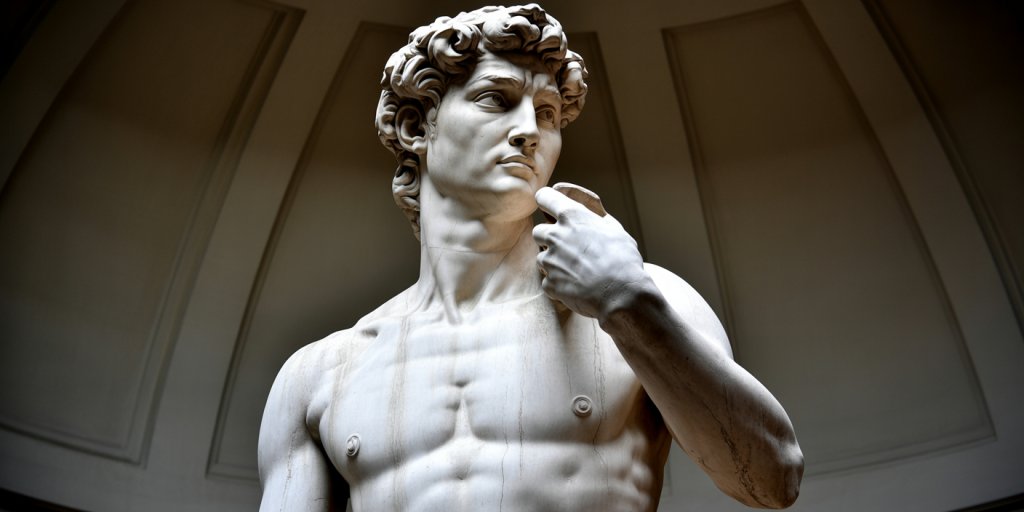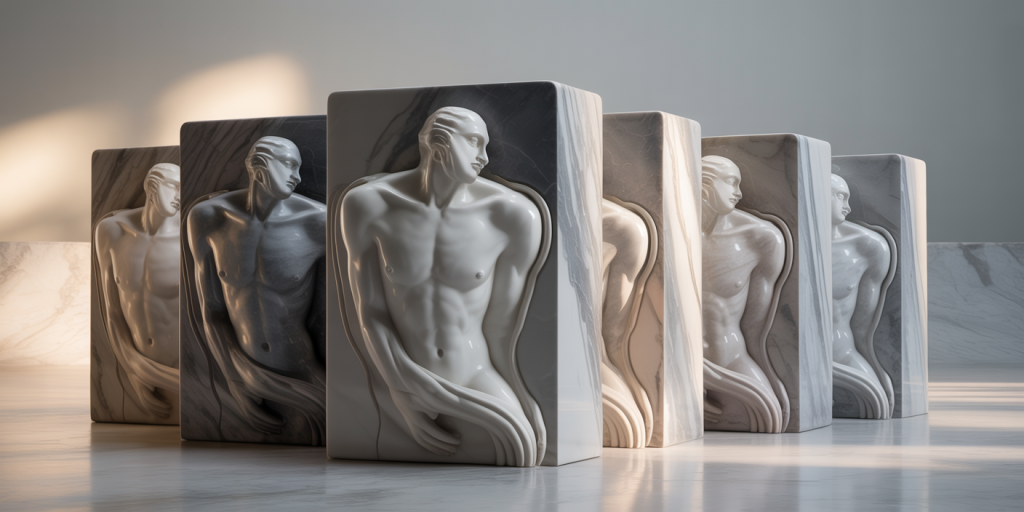Michelangelo’s Stone and the Whispers of a Soul to Come
There are stones that wait. Not passively, not silently, but with the breathless tension of a soul pushing outward. In the hands of Michelangelo Buonarroti, marble was never dead matter. It trembled. It yearned. His chisel did not strike to impose form—it liberated what was already there. Each sculpture was not made, but revealed, as if the figure inside had whispered its desire to be seen.
In the rough contours of unfinished limbs, in torsos emerging from the prison of stone, one senses the divine hesitation between being and becoming. Michelangelo’s sculptures are not merely forms—they are metamorphoses in progress. They are souls in the birth canal of eternity, caught between the eternity of marble and the mortality of flesh. In their silence, they speak. And in their stillness, they move.
Summary
- The Soul Hidden in Stone
- When Marble Dreams of Motion
- Bodies Caught in the Act of Becoming
- Shadows Within the Quarry
- The Chisel as Prophet
- Anatomy of a Whisper
- Muscles that Breathe in Stillness
- Light Carving the Divine
- Texture of the Incomplete
- From Dust, the Divine Emerges
- Limbs Bound by Stone
- Veins of the Sublime
- Eyes That See Without Opening
- Silence as Sculpture
- The Gravity of Gesture
- History Sleeping in White
- The Weight of a Breath
- Wounds of the Creative Act
- Between Flesh and Eternity
- When Form Refuses to Die
The Soul Hidden in Stone
Michelangelo believed that sculpture was not about shaping the stone but releasing the form already imprisoned within. His figures appear as if summoned—not forced. The soul lies dormant beneath the surface, waiting for the sculptor’s mercy.
This philosophy transforms the block into a metaphor: not raw material, but a sealed letter from God. The artist does not write the message—he opens it.
When Marble Dreams of Motion
Motion in Michelangelo’s work is not expressed through dynamic postures alone—it is suspended in tension. His statues are not frozen; they are pausing. One feels the breath before a movement, the final resistance of marble before surrendering to life.
The anticipation is more powerful than the act. The viewer becomes complicit in the sculpture’s next gesture, imagining where it would go if given one more moment.

Bodies Caught in the Act of Becoming
Nowhere is Michelangelo’s philosophy more tangible than in his “Prigioni” or “Slaves.” These figures seem to fight against their own substance. Some reach, others strain, some collapse back into the block, as if unsure whether to be born.
Their incompleteness is their message. We witness the sacred drama of formation—not yet body, no longer stone. They are metaphors for the human condition: beings always in the process of becoming.
Shadows Within the Quarry
In the subtle hollows of his sculptures, shadow becomes voice. Michelangelo masterfully manipulates light not only to define volume but to evoke emotion. Darkness gathers where uncertainty resides: beneath brows, behind knees, within parted lips.
The quarry is not empty stone—it contains shadowed secrets. Every crevice holds a sigh.
The Chisel as Prophet
Michelangelo’s chisel was no mere tool—it was oracle and scalpel. With each strike, he interpreted the divine plan embedded in the marble. He saw what others could not. His hand followed his inner vision, obeying what the stone demanded.
There is a sacred violence in this. Each blow is both death and birth, an act of precision and faith.
Anatomy of a Whisper
Michelangelo’s anatomical mastery is well-known, but in these unfinished works, we do not see anatomy—we feel it. Muscles swell from the stone like thoughts forming in the subconscious. There are no names for these bodies, no stories—just presence.
They are whispers given weight. Dreams clothed in muscle.
Muscles that Breathe in Stillness
Even when still, his bodies seem to breathe. The torsos twist as if exhaling, the necks tilt in longing. There is no movement, yet the air feels disturbed by their presence.
This is the magic of Michelangelo: the breathless illusion of breath.
Light Carving the Divine
Light does not merely illuminate these forms—it sculpts them. As sunlight or candlelight slides across the stone, it animates the frozen gestures. Every ripple becomes a wave, every fold a narrative.
In this divine interplay, Michelangelo allows God to finish what he began.
Texture of the Incomplete
The contrast between the polished skin and the rough stone is not an accident—it is a philosophy. The transition from coarse to smooth maps the journey from potential to form. The unfinished is not a flaw—it is testimony.
It tells us where the hand stopped. It shows the battle between will and material. It lets us witness the wound.

From Dust, the Divine Emerges
Michelangelo did not sculpt men—he sculpted echoes of the divine. Each figure reaches toward the sacred, toward meaning beyond flesh. They are not mere representations of human bodies but embodiments of spiritual striving.
Even in dust, there is divinity. Even in the half-formed, there is holiness.
Limbs Bound by Stone
The limbs of his slaves twist not freely, but in resistance. The stone clings to them like doubt. They reach, but something holds them back. They strain, yet the stone answers with silence.
These limbs are not imprisoned—they are becoming. They are gestures still negotiating their place in the world.
Veins of the Sublime
Look closely and you may see veins. Not real ones, but hints—channels of life carved subtly into the marble. These veins are not anatomical—they are poetic. They carry not blood, but longing.
They are the silent paths of desire running beneath the surface.
Eyes That See Without Opening
Many of Michelangelo’s unfinished figures have no eyes—or rather, they have not yet opened them. But the gaze is there, implied in the tilt of the head, in the arch of the brow.
They do not need irises to see. Their vision is internal. They behold not the world, but the moment of awakening.
Silence as Sculpture
These sculptures do not speak in words. They communicate through mass and pause, through roughness and relief. They are the silence between thoughts, the hush before revelation.
Michelangelo carved silence itself. And in it, we find resonance.
The Gravity of Gesture
Each gesture carries weight—not physical, but emotional. A hand reaching skyward is not just anatomy; it is prayer. A twisted torso is not discomfort; it is defiance.
The gravity in these gestures makes them timeless. They anchor us in the eternal present of their struggle.

History Sleeping in White
Marble has a memory. In Michelangelo’s hands, it remembers the mountain, the quarry, the centuries of stillness. When shaped, it does not forget—it becomes.
The white surface contains centuries. His sculptures are history dreaming aloud.
The Weight of a Breath
Though made of stone, the figures are impossibly light. One senses that if they could move, they would dissolve into air. They carry the weight of breath held too long.
They teach us that heaviness is not about mass, but meaning.
Wounds of the Creative Act
Sculpting is not clean. It is an act of wounding. Michelangelo’s chisel does not smooth—it breaks, chips, tears. The beauty is born in violence.
But this is not brutality—it is intimacy. Each strike is a gesture of love. Each wound, a step closer to freedom.
Between Flesh and Eternity
Michelangelo’s unfinished works live between worlds. They are not yet flesh, but no longer mere stone. They are eternal in their incompletion, perfect in their imperfection.
They remind us that becoming is more honest than being. That the soul is always sculpting itself, even after the chisel rests.
When Form Refuses to Die
Even when unfinished, these forms endure. They haunt us not because of what they lack, but because of what they still hold. They refuse to be dismissed. They refuse to die.
They whisper. And in that whisper, we hear the voice of eternity.
FAQ – Frequently Asked Questions
Who was Michelangelo Buonarroti?
Michelangelo (1475–1564) was a Florentine sculptor, painter, architect, and poet. He is considered one of the greatest artists of the Renaissance and of all time, known for masterpieces like David, the Sistine Chapel ceiling, and the Pietà.
What are the “Prigioni” or “Slaves”?
The “Prigioni” are a series of unfinished sculptures by Michelangelo that depict male figures partially emerging from marble blocks. They were originally intended for the tomb of Pope Julius II but were never completed.
Why are these works unfinished?
Many of Michelangelo’s unfinished pieces were left that way due to changes in commissions or his evolving artistic vision. He often believed the form was complete when it fully expressed its internal truth—even if technically incomplete.
What materials did Michelangelo use?
Michelangelo primarily worked in marble, which he considered a noble, living material capable of holding spiritual and emotional resonance.
What is the artistic philosophy behind his sculpture?
He believed that the form already existed within the stone and that the artist’s role was to uncover it. This belief gives his work a mystical, almost prophetic quality.
Final Reflections – The Echo of the Stone
Michelangelo did not merely shape stone—he listened to it. He stood before a block of marble as one might stand before a mystery, asking not “What can I create?” but “Who are you?”
His unfinished works are not fragments—they are revelations in progress. They remind us that art does not need to conclude to be complete. That the soul, like sculpture, is always arriving.
And as we stand before these figures, half born, half divine, we too begin to feel the stone within us shift—the chisel of time carving our own becoming.
